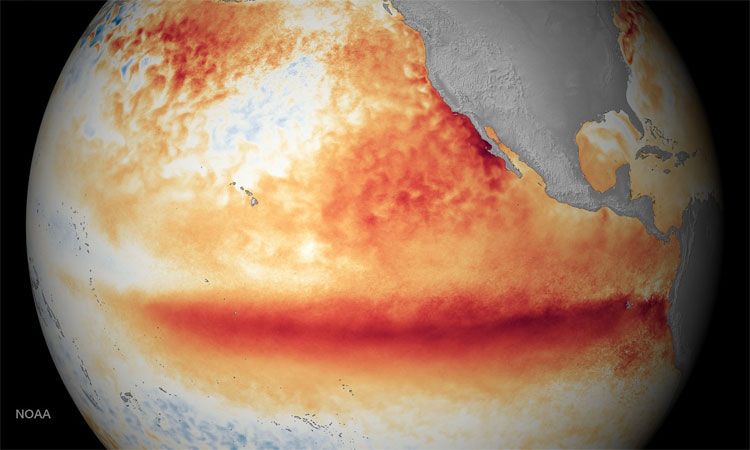In addition to El Nino, this is what makes the Earth hot
El Tío and La Tía are two types of climatic cycles that take place for tens of years, which have great impacts on the weather on the whole Earth but have not been really discussed and studied. Recent scientists have said they have a great impact on the occurrence of extreme weather patterns on the planet.
El Niño is a type of climate that brings out drier and hotter weather than usual in summer in Australia. This type of climate is even more negative when the greenhouse effect occurs more due to human polluting activities.
El Niño occurs due to weather changes in the Pacific Ocean. In contrast to it is the La Niña climate type, which occurs every 2 to 7 years, also known as the El Niño Southern Oscillation (ENSO).
However, there is another type of climate that has a significant impact on the climate of this area, but it is less discussed and studied. Its name is Pacific Oscillation (IPO), which is a change in rainfall, temperature, river water flow and crop yields in Australia for decades.
From El Niño and La Niña in Spanish means boy and girl.Two new types of IPO weather are called in another way, El Tío (uncle, uncle) and its opposite is La Tia (aunt, aunt).
Movements and consequences of El Tío and La Tia are very difficult to predict . They were likened to the drunken uncle and aunt during a family gathering, it was hard to predict what they would say during that meal.

El Niño phenomenon in 2015 in the Pacific Ocean.(Photo: NOAA).
Like El Niño Southern Oscillation (ENSO), the Pacific Multifarious Oscillation (IPO) is related to the movement of warm water around the Pacific Ocean. But IPO has a long-term effect, from every 10 years to 30 years a cycle, much longer than ENSO's 2 to 7 year cycle.
The IPO model is similar to ENSO, making scientists hypothesize that they have a close association with each other. They are only different at the interval of each cycle.
We still do not have a clear knowledge of whether the IPO is a specific climate type, and whether it is a combination of different types of climate in the ocean and atmosphere.
Although there are still many unknowns, we are sure that the IPO affects global warming. In the 2000s, it caused the global temperature rise to be interrupted and reduced.
When it comes to global warming, we will immediately think of the huge emissions of greenhouse effect, due to the impact of the industrial revolution, causing the entire planet to heat up.
But perhaps few people know that El Tío and La Tia also have a significant impact on our weather and climate from year to year, from decade to decade.
Some recent studies show that IPO weather patterns, El Tío and La Tia can cause the planet's temperature to rise or fall temporarily during a certain period.
Rainfall in the world is also affected by El Tío and La Tia, which cause specific impacts such as floods and droughts in the United States, China, Australia and New Zealand.
In the positive phase of the IPO, called La Tia, the temperature of the Pacific Ocean will be cooler than normal near the equator, and will be hotter than usual compared to the equatorial areas.
Since about 2000, a portion of the excess heat of the greenhouse effect has been trapped and buried deep in the Pacific Ocean, leading to global warming delays of about 15 years.
La Tia is a type of climate with positive developments , causing global warming to level off. In contrast to it is El Tío, a type of climate that causes global warming to rise rapidly, as was the period from the 1970s to the late 1990s.
One of the challenges for scientists is to clarify the climate situation around the world in the next few decades. To learn this, they built a model of Earth's climate on computers.
This model fosters its role in Earth's climate simulation, but has yet to accurately simulate the slow transition of both El Tío and La Tia that we witness in the real world.
IPO is a new topic that needs to be discussed and researched in the weather and climate of the coming years. It is a kind of realistic climate going on, which can explain many unusual weather phenomena happening on Earth.
- El Nino makes winter 2009 warmer
- El Nino 2015 looks strange with the peak of 1997
- Earth warms weaken El Nino's function to prevent storms
- El Nino changes may cause many storms to land
- Nature is angry, El Nino will be more intense
- Can 2015 El Nino cause more natural disasters?
- The origin of the term El nino
- Predict the hot sun record in 2014
- El Nino can last until May 2010
- El Nino is coming back
- El Nino is about to end in the Caribbean
- NASA: We are experiencing the peak of El Nino
 Is the magnetic North Pole shift dangerous to humanity?
Is the magnetic North Pole shift dangerous to humanity? Washington legalizes the recycling of human bodies into fertilizer
Washington legalizes the recycling of human bodies into fertilizer Lightning stone - the mysterious guest
Lightning stone - the mysterious guest Stunned by the mysterious sunset, strange appearance
Stunned by the mysterious sunset, strange appearance